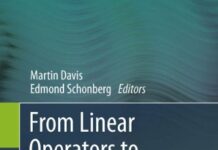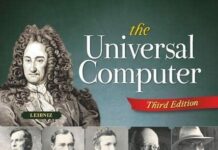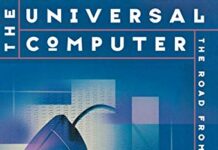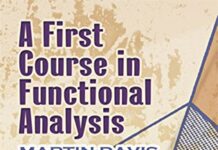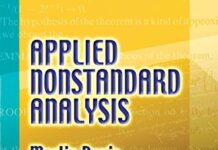
Ebook Info
- Published: 2013
- Number of pages: 248 pages
- Format: PDF
- File Size: 13.43 MB
- Authors: Martin Davis
Description
In this classic text, Dr. Davis provides a clear introduction to computability, at an advanced undergraduate level, that serves the needs of specialists and non-specialists alike.In Part One (Chapters 1–5), Professor Davis outlines the general theory of computability, discussing such topics as computable functions, operations on computable functions, recursive functions, Turing machines, self-applied, and unsolvable decision problems. The author has been careful, especially in the first seven chapters, to assume no special mathematical training on the part of the reader.Part Two (Chapters 6–8) comprises a concise treatment of applications of the general theory, incorporating material on combinatorial problems, Diophantine Equations (including Hilbert’s Tenth Problem) and mathematical logic. The final three chapters (Part 3) present further development of the general theory, encompassing the Kleene hierarchy, computable functionals, and the classification of unsolvable decision problems.When first published in 1958, this work introduced much terminology that has since become standard in theoretical computer science. Indeed, the stature of the book is such that many computer scientists regard it as their theoretical introduction to the topic. This new Dover edition makes this pioneering, widely admired text available in an inexpensive format.For Dover’s edition, Dr. Davis has provided a new Preface and an Appendix, “Hilbert’s Tenth Problem Is Unsolvable,” an important article he published in The American Mathematical Monthly in 1973, which was awarded prizes by the American Mathematical Society and the Mathematical Association of America. These additions further enhance the value and usefulness of an “unusually clear and stimulating exposition” (Centre National de la Recherche Scientifique, Paris) now available for the first time in paperback.
User’s Reviews
Reviews from Amazon users which were colected at the time this book was published on the website:
⭐The book introduces the theory of computability and non-computability to the mathematically-comfortable. The theory of recursive functions provides entry to that theoretical territory at the limits of what is computable and what is solvable. The theory is relevant to important philosophical questions and also in the theory of computing and what is possible (and never possible) by use of computing machines.The result for philosophy is establishment of absolutely unsolvable problems and undecidable questions, even ones that can be completely and precisely formulated using rigorous logic. The result for computing is problems that are absolutely unsolvable by use of a computer program.So what problems are theoretically solvable by a computer program? First, the Universal Turing Machine (UTM) is presented along with the famous demonstration that all universal computers are equivalent in the sense that any one of them can be made to simulate any of the others, using a suitable representation.So, if we establish that the computer we have at hand is a universal computer, we can be confident that, in principle, anything that any computer can compute, this one can also.The book goes on to address what even universal computers can’t do. The most well-known result in computer-science circles is the unsolvability of the halting problem. That is, if the computer is powerful enough to be universal, one of its limitations is the impossibility of an algorithm that will determine whether any program for that machine will always terminate for all inputs. It is as if the price of universality is the inevitability of programs that won’t finish, along with having no absolute way of telling whether arbitrary given programs will finish or not.Davis maps the boundary between the impossible (the unsolvable) and the merely inhumanly difficult (the computable). With that foundation, one can move on to other work that introduces what has been learned about computational complexity and how to apply the analysis of algorithms to finding computational methods that are practical and no more complex than absolutely necessary.The book is an essential part of my library because of its availability and its standing as a fundamental reference in the theory of computation. Church’s Thesis and the development of effective computability via the lambda-calculus and combinatory logic is neglected more than suits me. Available supplementary references are needed for access to those alternative formulations that promise to bear directly on having operational, practical computer systems that function at the limits of computability.
⭐Martin Davis’ “Computability and Un-solvability” has been used as the textbook of a graduate course offered by the author at the University of Illinois and a series of lectures at Bell Telephone Laboratories. The style of the book is mathematically formal. Its primary elements are definitions, lemmas, theorems, and proofs. For the readers, who are pursuing to understand more about the Hilbert’s tenth problem, algorithm, and recursively enumerable sets, would find this book interesting. The first five chapters are about the general theory of computability, which is the concern of the existence of algorithm–purely mechanical procedures for solving various problems (no creative thought is needed while executing the procedure). First of all, the author introduces Turing machines (A Turing machine is a finite (nonempty) set of quadruples that contains no two quadruples whose first two symbols are the same). Then Davis introduces the definition of the computation of a Turing machine (a finite sequence of instantaneous description of a Turing machine), symbolic representation for numbers (5=SiSiSiSiSi), partially computable functions (the existence of a Turing machine whose resultant is equivalent to f(x1,x2,…,xn), computable functions (f(x1,x2,…,xn) is a total function), recursive functions (a function can be obtained by a finite number of applications of composition and minimalization of regular functions), and unsolvable decision problems (the non-existence of an algorithm for deciding the truth or falsity of whole class of statements). Chapter 6 to chapter 8 are about the applications of the general theory of computability, which includes the applications on combinatorial problems, Diophantine Equations (Hilbert’s tenth problem is recursively unsolvable.), and mathematical logic (incompleteness and un-solvability theorems for logics). A glimpse of the “decisive limitation on the power of logics” (Godel’s famous incompleteness theorem) is also presented. Chapter 9 to chapter 11 is about the further development of the general theory of computability. There are two appendixes related to mathematics. The first appendix is the fundamental facts of the elementary number theory. The second appendix is the author’s paper “Hilbert’s Tenth problem is unsolvable.” The readers would need a clear concept on computable functions, effectively calculable functions, and algorithm to understand both the general theory of computability and the Hilbert’s Tenth problem.
⭐We are in 1958, Davis is writing from the border between mathematics and computer science. He assumes that you know a great deal about Turing machines, Godel’s numbers + incompleteness theorems, and is familiar with their original notations. Non-mathematicians like myself might get scared with the notation (e.g. while wrestling with the “arithmetization theory of Turing machines”, what?!); it may even make you cry. Then he goes incrementally showing operations with computable functions, recursive functions and listing difficulties with decision problems. One proof after another. The cross-references among the several theorems in this book will make you behave like a Turing machine going furiously back and forth trying to “compute” this book. A great challenge indeed.
⭐This book did a very good job treating various aspects of computability. I found it extremely theoretical and formal, which is exactly what it set out to be.However, I think that what it lacks are less formal comments to accompany the heavy formalised theorems. I often found myself asking ‘But what does this mean?’ after reading the proof of a theorem. While it does give some plain English explanations, I would have liked it to have more. I cannot take away any stars because of this, due to the fact that it is ‘advertised’ as a technical book, not a philosophical one.
⭐A wonderful treatise on the limits of current theory by my dear friend Professor Martin Davis, one of the very best mathematicians alive today and dealing with computation.
⭐Good, quality materials.
⭐This is a mathematical overview of computability. It is not a book about computability. I am a keen graduate student of mathematical aspects of computing, including computability, but I struggled at several places in this book.
Keywords
Free Download Computability and Unsolvability (Dover Books on Computer Science) in PDF format
Computability and Unsolvability (Dover Books on Computer Science) PDF Free Download
Download Computability and Unsolvability (Dover Books on Computer Science) 2013 PDF Free
Computability and Unsolvability (Dover Books on Computer Science) 2013 PDF Free Download
Download Computability and Unsolvability (Dover Books on Computer Science) PDF
Free Download Ebook Computability and Unsolvability (Dover Books on Computer Science)
